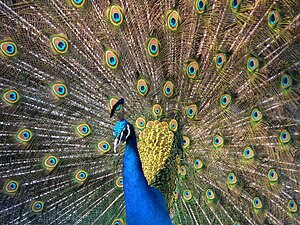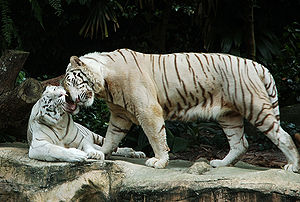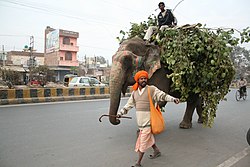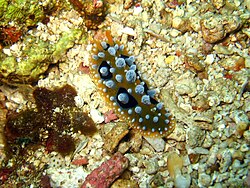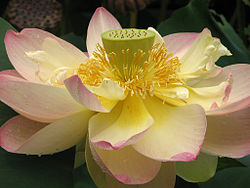Archives:Image of the month
From Biodiversity of India
|
February 2011
Species description by: Supriyak
Pictured here is Turmeric truly called the Legendary Herb of India. Turmeric, best known as “Haridra” in Sanskrit, has a rich history in India and is highly esteemed and considered auspicious by Indian people. The Hindus consider it as a symbol of prosperity and as a cleansing herb for the whole body. Since ancient times, turmeric has been used as a traditional medicine and for beauty care.The powdered form of turmeric rhizome is used in food preparations for its freshness, palatability, nutritive value and presentation of food. The brilliant-yellow color of turmeric, which is resistant to very high dilutions, is used as a coloring agent for various items including cotton, silk, paper, wood, foodstuffs and cosmetics. Ayurveda the oldest systems of medicinal practice in world has explored the benefits of turmeric and put it to use, for treating digestive disorders, as antiseptic for cuts and burns, as anti-inflammatory agent, as a blood purifier and as a remedy for range of conditions including tonsillitis, headaches, wounds, snake bites, stings, sprains and fractured bones. Turmeric has been household remedy in India for ages; it is tightly knit with Indian culture and tradition for its benefits and medicinal properties. |
|
March 2011
Species description by: Supriyak
A male Indian Peafowl, flaunting a gleaming blue breast and neck and a spectacular bronze-green train of around 200 elongated feathers, its tail erect like fan, an ostentatious display. The Indian Peacock is one of the largest flying birds in the world. The wings combined with the train makes it so. The feathers in the train consist of an eye spot and long disintegrated parallel filaments projecting from its main shaft. When the peacock displays its fan shaped crest of feathers it is indeed a very magnificent sight to behold. Peacock is an emblematic of qualities such as beauty, grace and pride and is the National Bird of India. Peacock is multi-hued, swan-sized bird, with a fan-shaped crest of feathers, a white patch under the eye and a long, slender neck. Peacock is often illustrated in pictures accompanying Indian Gods and Goddesses. The peafowl is prominent in the mythology and folklore of the Indian people. The Hindus consider the bird to be sacred because the god Kartikeya (son of the Lord Shiva and Parvati and brother to the god Ganesh) rides on its back. Legends hold that the peafowl can charm snakes and addle their eggs. On seeing the dark clouds, peacock outspreads its tail and starts dancing in rhythmic fashion. Its dance movement has been incorporated in most of the Indian folklore, including Bharatha Natyam. |
|
February 2011
Species description by: Supriyak
White tigers are very rarely found in the wild. In about 100 years only 12 white tigers have been seen in the wild habitats of India.The white tigers have round blue eyes and these also have better night vision. Like all members of the cat family, the white tigers also have retractable claws and these are used to scratch trees as a way to mark their territorial boundaries. The stripes on the body of the tigers help the body to be camouflaged better in the wild. Another interesting fact about tigers is that the pattern of the stripes is never the same for any tiger. Like every fingerprint which is different for most humans, the stripes differ in tigers as well.White tigers are born to Bengal tigers that carry an unusual gene needed for white coloring.This royal, majestic and beautiful, the white Bengal tigers (Panthera tigris) are slowly depleting in their numbers.They are almost extinct and most of the ones living are in captivity, mainly in zoos. All white tigers in captivity in the world today are the descendants of one white tiger, Mohan caught by the Maharaja of Rewa in the year 1951. |
|
January 2011
Species description by: Gauravm
The Indian Elephant (Elephas maximus indicus) is one of four subspecies of the Asian Elephant, the largest population of which is found in India. Elephants have been used in India since ancient times; they have been used for religious and stately processions, hunting, wars and transportation. Elephant is revered as a sacred animal in Indian culture, an example of which is Lord Ganesha who is shown to have the head of an elephant. Elephants are the largest known land animals and have the largest brains in the animal kingdom weighing up to 5kgs. The elephant's gestation period is 22 months, the longest of any land animal. Due to their long gestation period, huge bodies and especially the value of their ivory tusks and bones, they have been hunted for a long time almost to a point of extinction. In addition to hunting, habitat loss is also severely threatening the existing populations. In recent times however, environmental conservation projects have begun to take up the task of preserving the remaining habitats to ensure the survival of these magnificent creatures. |
|
December 2010
Species description by: Gauravm
Many of us who have seen the popular children's animated series Mowgli know this animal as Pappu(Kichi in international versions of Jungle Book), Mowgli's trusted and loved pet whose parents had been killed by humans. The story has come to be real for these Red Pandas, who have been classified as Vulnerable by IUCN with only ~10,000 mature individuals remaining. The red panda (Ailurus fulgens or Shining cat) is endemic to the temperate forests of the Himalayas, and ranges from the foothills of western Nepal to China in the east. In India, it has been documented in West Bengal, Sikkim and Assam (and probably in Arunachal Pradesh). The red panda is considered a living fossil and only distantly related to the Giant Panda (Ailuropoda melanoleuca). The species is quite adaptable to living in captivity and this attribute has helped stem the decline in its populations. |
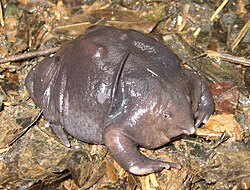 The Purple Frog Nasikabatrachus sahyadrensis |
November 2010
Species description by: Gauravm
This amazing creature is a species of frog found only in the Western Ghats of India. Named Nasikabatrachus sahyadrensis or the Purple Frog, it is a very recently discovered endangered species. The scientific name derives from the Sanskrit word nasika (nose) referring to the pointed snout, batrachus Greek for frog, and Sahyadri as the local name of the Western Ghats. Compared to other frogs, N. sahyadrensis has a more rounded body, a small head and an unusual pointed snout. Interestingly, the cry of the frog resembles more like a chicken than a frog. Close relatives of the frog are found in Seychelles and Madagascar, the land masses to which India was joined several million years ago. |
|
October 2010
Species description by: Gauravm
Jasminum sambac, also called Common Jasmine, is a very popular ornamental flower grown for its beautiful flowers and sweet fragrance. In fact, the name Jasmine is derived from the Persian Yasmin meaning Gift from God. Jasmine flowers are used in many religious occasions as offerings to Gods. Garlands made from Jasmine flowers, as shown above, are adorned by women during special occasions. The fragrance of Jasmine flowers comes from volatile terpenoid chemicals produced in the flowers. These terpenoids are of great demand in the perfume industry. As a result of these uses, there are several dozen varieties of Jasmine flowers in cultivation all around the world. This flower is a great example of how information about the uses of biodiversity can go a long way in ensuring their survival. |
|
September 2010
Species description by: Gauravm
Phyllidia ocellata, a sea slug living in the coral reefs, displays such bright colors to warn off predators. This slug was discovered during one of the expeditions of the Census of Marine Life, a massive 10-year long project to document the creatures living in our seas and oceans. The census, contributed to by over 80 countries and 2700 scientists, led to the discovery of 5300+ new, never before documented species in Earth's seas. The report of the census (which has already generated 6000+ publications) was published on October 4, 2010. |
|
August 2010
Species description by: Gauravm
Nelumbo nucifera, also known as the Indian Lotus or the Sacred Lotus, is a culturally significant plant in many Asian cultures in general and Indian culture in particular. It is a plant native to the Indian subcontinent, but now is found as an ornamental plant worldwide. The Lotus is considered a symbol of devotion and purity. It is the seat of Goddess Lakshmi, Goddess Saraswati, Lord Vishnu and Lord Brahma. The plant also has several medicinal properties. |

